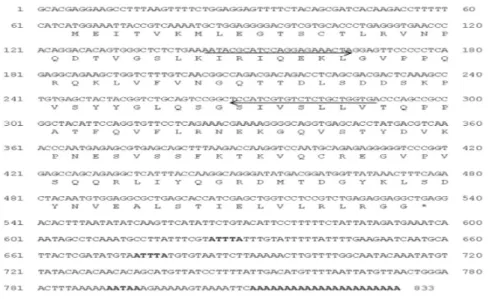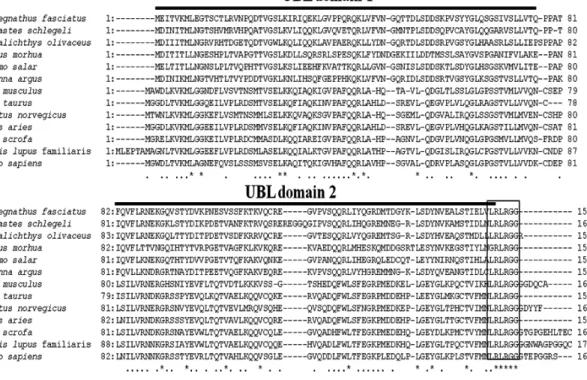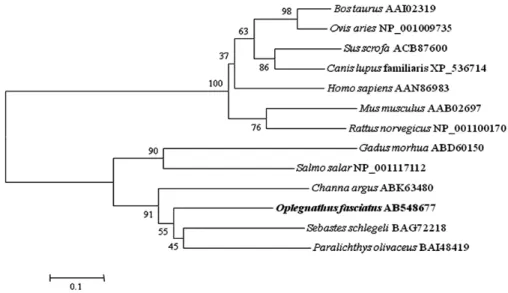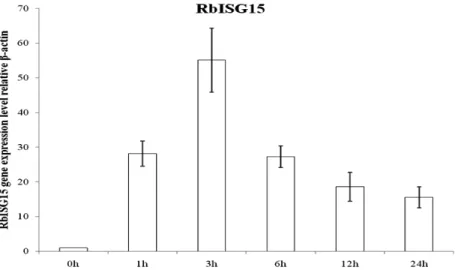Molecular cloning and expression analysis of an interferon stimulated gene 15 from rock bream Oplegnathus fasciatus
Ju Won Kim, Mun Gyeong Kwon*, Myoung Ae Park*, Jee Youn Hwang*, Hyung Jun Park, Gun Wook Baeck, Mu Chan Kim** and Chan Il Park†4)
Department of Marine Biology & Aquaculture, Institute of Marine Industry, College of Marine Science, Gyeongsang National University, 455, Tongyeong 650-160, Korea
*Pathology Division, National Fisheries Research and Development Institute, Busan 619-900, Korea
**Department of Marine Environmental Engineering, Institute of Marine Industry, College of Marine Science, Gyeongsang National University, 455, Tongyeong 650-160, Korea
The interferon stimulated gene 15 (ISG15) is strongly induced in many cell types by IFNs, viral infections, and double-stranded RNA (poly I:C). The ISG15 homologue cDNA was isolated from the rock bream LPS stimulated leukocyte cDNA library. The rock bream ISG15 homologue was found to consist of 833 bp encoding 157 amino acid residues. Compared with other known ISG15 peptide sequences, the most conserved regions of the rock bream ISG15 peptide were found to be the tandem ubiquitin-like domains and a C-terminal LRLRGG conjugating motif, characteristic of mammalian and non-mammalian ISG15 proteins. Phylogenetic analysis based on the deduced amino acid sequence revealed a homologous relationship between the ISG15 sequence of rock bream and that of Atlantic salmon, Atlantic cod, northern snake head, black rockfish and olive flounder. The expression of the rock bream ISG15 molecule was induced in the peripheral blood leukocytes (PBLs) from 1 to 24 h following poly I:C stimulation, with a peak at 3 h post-stimulation. The rock bream ISG15 gene was predominantly expressed in the PBLs, spleen and gill.
Key words : Rock bream, ISG15, Interferon, PolyI:C, Real-time PCR
There are two types of immunity, innate immunity and adaptive immunity, which have different roles against the infection of pathogens (Dempsey et al., 2003). Especially, innate immunity acts as the first line of host defense. Both types of immunity are controlled by the network system and by intracellular and extracellular factors (Banyer et al., 2000; Hawiger, 2001). All vertebrate groups, from fish to mammals, possess type I IFNs which play a crucial role in the innate immune
†Corresponding Author: Chan-Il Park, TEL : 82-55-640-3103, FAX : 82-55-642-4509, E-mail : vinus96@hanmail.net
defense against viral infections, and also possess antiproliferative and immunomodulating properties (Robertsen, 2006). Type I IFNs are induced by virus infection and stimulated antiviral responses in cells by inducing hundreds of interferon stimulated genes (ISGs) through the JAK-STAT (Janus kinase-signal transducers and activators of transcription) pathway (de Veer et al., 2001). Similar to their mammalian counterparts, the fish type I IFN inducible genes can be induced by virus infection and poly I:C, a synthetic analog of double-stranded RNA (dsRNA) (Zhang et al., 2007).
ISG15 is one of the earliest and predominant proteins to be synthesized in response to IFN stimulation, virus infections, double-stranded RNA (poly I:C), and lipopolysaccharides (LPS). This suggests that ISG15 has an important function in the IFN system (Ritchie and Zhang, 2004; Dao and Zhang, 2005; Pitha-Rowe and Pitha, 2007). ISG15 is composed of two tandem repeats of ubiquitin-like domains and like ubiquitin, can be conjugated to target proteins via its C-terminal LRLRGG motif (Haas et al., 1987; Loeb and Haas, 1992). This motif is required for the covalent conjugation of ISG15 via an isopeptide bond to cellular targets (protein ISGylation) as a primary response to type I IFNs induction and other markers of viral or bacterial infection (Loeb and Haas, 1992). Unlike ubiquitination, ISGylation does not appear to be target proteins for proteasome degradation (Malakhov et al., 2003), but it activates or suppresses the function of target proteins (Zou et al., 2005; Takeuchi and Yokosawa, 2005).
ISG15 has been reported in several fish species including Atlantic cod (Gadus morhua), goldfish (Carassius auratus), Atlantic salmon (Salmo salar), crucian carp (Carassius carassius), black rockfish (Sebastes schlegelii), and rainbow trout (Oncorhynchus mykiss) (Liu et al., 2002; O’Farrell et al., 2002; Seppola et al., 2007; Røkenes et al., 2007; Zhang et al., 2007;
Baeck et al., 2008). Related with IFN systems, three isoforms of the Mx gene have been characterized in rock bream (Zenke and Kim, 2009), but ISG15 has not been identified. Rock bream (Oplegnathus fasciatus) is an important species aquaculture species in Korea due to its high market value and the high consumer demand.
However, the total production of this species is not
satisfactory compared to other commercially important fishes in Korea (Lee et al., 2009) due to the RSIV disease, which has been the major culprit of the mass mortality of rock bream in Korea (Sohn et al., 2000; Jung and Oh, 2000). To improve the rock bream production efficiency, it is necessary to understand the molecular processes involved in the antiviral responses in this species. In this paper, the cloning, characterization, and expression analysis of the ISG15 cDNA from rock bream are reported.
Materials and Methods
Identification of rock bream ISG 15 cDNA Rock bream ISG 15 full-length cDNA was identified via the EST analysis of the LPS stimulated PBLs library (Lee et al., 2009). 5’-termini base sequencing of the selected cDNA clones in phagemid form was performed using an ABI 3100 automatic DNA sequencer (PE Applied Biosystems, CA, USA) and an ABI Prism Big Dye Terminator Cycle Sequencing Ready Reaction kit (PE Applied Biosystems, USA). Bioinformatic analysis was conducted to determine the gene identities, using the Genetyx ver. 8.0 software (SDC Software, Japan).
Briefly, the vector sequences were removed, and the database search was limited to the ESTs that are >400 bp in length.
Sequence analysis and alignment
The sequence of Rb-ISG15 cDNA was compared with the sequences in the peptide sequence databases at the National Center for Biotechnology Information (NCBI), using the BLAST network service. Nucleotide sequence
comparisons were carried out using the BLASTX program (Gish and David, 1993).
The multiple alignment of the amino acid sequence of the Rb-ISG15 proteins was performed using the Clustal W program (Thompson et al., 1994). The sequences that were used for the comparison and their GenBank accession numbers were as follows: Black rockfish ISG15 (BAG72218), Olive flounder ISG15 (BAI48419), Atlantic salmon (NP_001117112), Snakehead ISG15 (ABK63480), House mouse ISG15 (AAB02697), Cattle ISG15 (AAI02319), Norway rat interferon alpha-inducible protein (NP_001100170), Sheep ISG17 (NP_001009735), Pig ISG15 (ACB87600), Dog interferon alpha-inducible protein (XP_536714), and Human ISG15 (AAN86983).
The phylogenetic relationships were inferred using the Mega 4 program and distance analysis through the neighbor-joining method. The values supporting each node were derived from 2,000 re-samplings.
RT-PCR analysis of the ISG15 transcripts in different tissues
Eight tissues (PBLs, head kidney, trunk kidney, spleen, liver, intestine, gill, and muscle) were isolated
from approximately 300 g healthy rock bream. The total RNA from each tissue was extracted using TRIzol reagent (Invitrogen, USA), according to the manufacturer’s instructions. First-strand cDNA synthesis was carried out using a first-strand cDNA synthesis kit (Takara, Japan), according to the manufacturer’s instructions. The first-strand cDNAs were used as a PCR amplification template, with the specific primers. The oligonucleotide primers used to amplify the RbISG15 cDNA fragment were OFISG15-F and OFISG15-R. Thermal cycling was performed using TaKaRa PCR Thermal Cycler (Takara, Japan) with ExPrime Taq premix (GENET BIO, Korea) as follows: predenaturation at 94℃ for 5 min, 25 cycles of denaturation at 94℃ for 30 s, annealing at 58℃ for 1 min, extension at 72℃ for 1 min, and final extension at 72℃ for 7 min. The expression of rock bream 18S rRNA was used as the internal control (Cho et al., 2009).
The primers Rb18S-F and Rb18S-R were used for amplifying rock bream 18S rRNA. The PCR amplification products were observed on 1.5% agarose gel electrophoresis with a 100-bp DNA ladder (Takara, Japan). The primer sequences used in this study are listed in Table 1.
Primer name Sequence(5’-3’) Usage
OFISG15-F ATACGCATCCAGGAGAAACTA RT-PCR,
Real-time PCR OFISG15-R TCACCAGCAGAGACACGATGGA
Rb18S-F ACGGGGAATCAGGGTTCGAT
RT-PCR Rb18S-R AGAATTTCACCTCTAGCGGC
β-actin-F TTTCCCTCCATTGTTGGTCG
Real-time PCR
β-actin-R GCGACTCTCAGCTCGTTGTA
Table 1. Primers used for all the experiments
Real-time PCR analysis
Rock bream (200-250 g) was purchased from the Fisheries market in Tong-yeong, Korea. Peripheral blood samples were collected in a heparinized (100 Ul) syringe from the caudal blood vein. Peripheral blood leukocytes (PBLs) isolation and PBLs stimulation with poly I:C (5 ㎍/ml) were carried out as a previously reported method (Beack et al., 2008). The total RNA was extracted, and first-strand cDNA synthesis was performed as described above. Real-time PCR was performed on a Thermal cycler Dice real time system (Takara, Japan) with SYBR Green I (Takara, Japan).
The threshold cycle (Ct) values were automatically calculated as follows: the cycle when the fluorescence of the sample exceeded a threshold level corresponding to 10 standard deviations of the mean of the baseline fluorescence. Amplification was performed as follows:
1 cycle at 94℃ for 2 min and 30 cycles at 94℃ for
30 s, 60℃ for 30 s and 72℃ for 1 min, with a final extension step of 72℃ for 5 min. β-actin was detected as an internal control. All the samples were analyzed in triplicate and the expression of target genes was calculated as relative folds of the expression of β-actin according to the 2−ΔΔCT methods (Livak and Schmittgen, 2001).
Results
Cloning and sequencing of rock bream ISG15 cDNA The full-length ISG15 cDNA was 833 bp long and contained an open reading frame (ORF) of 471 bp that encoded 157 amino acid residues. The 5’ UTR was 64 bp in length, and the 3’ UTR 298 bp, and they contain a two mRNA instability motif (ATTTA), polyadenylation signal (AATAA) and a polyadenylation site (accession number: AB548677) (Fig. 1).
Fig. 1. Nucleotide and deduced amino acid sequences of rock bream ISG15. The oligonucleotide primers that were used in the study are indicated with arrows. The ATTTA sequence and polyadenylation signal AAUAAA is indicated in boldface.
Sequence alignment and phylogenetic analysis The deduced amino acid sequence of rock bream had a 66.6% identity with that of Black rockfish ISG15, 63% with Snakehead ISG15, 62% with Olive flounder ISG15, 55.4% with Atlantic salmon ISG15, 42.1% with Atlantic cod ISG15, 34.6% with Human ISG15, 33.9%
with Cattle ISG15, 32.6% with House mouse ISG15, 32% with Sheep ISG15, 31.8% with Pig ISG15, 31.4%
Dog interferon alpha-inducible protein, and 30.7% with Norway rat interferon alpha-inducible protein (data not
shown). The amino-acid sequence analysis indicated the existence of two consensus ubiquitin-like domains and C-terminal LRLRGG conjugating motif which are characteristic of mammalian and nonmammalian ISG15 proteins. (Fig. 2). The phylogenetic analysis indicated that rock bream ISG15 forms another teleost ISG15 group and is closest to that of black rockfish ISG15 among the examined species. This grouping was well-supported by bootstrapping (Fig. 3).
Fig. 2. Comparison between the rock bream ISG15 amino acid sequence and other known ISG15 sequences. The amino acids identical to the rock bream sequence are indicated by an asterisk (*), and the absent amino acids are indicated by dashes (–). The lines above the sequences marked with two different UBL domains and the Ub-conjugation domain (LRLRGG) are boxed.
Fig. 3. Neighbor-joining tree of ISG15 constructed with Mega4. The bootstrap confidence values shown at the nodes of the tree are based on 2000 bootstrap 2000 replications (DDBJ/EMBL/GenBank Accession numbers: Rock bream ISG15, AB548677; Black rockfish ISG15, BAG72218; Olive flounder ISG15, BAI48419; Atlantic salmon, NP_001117112;
Snakehead ISG15, ABK63480; House mouse ISG15, AAB02697; Cattle ISG 15, AAI02319;
Norway rat interferon alpha-inducible protein, NP_001100170; Sheep ISG17, NP_001009735;
Pig ISG15, ACB87600; Dog interferon alpha-inducible protein, XP_536714; Human ISG15, AAN86983).
Expression of the ISG15 gene in different tissues The expression of the ISG15 gene in the rock bream tissues was detected via RT-PCR. The ISG15 gene was expressed in all the tissues of the rock bream. The
expression was found to be predominantly in the PBLs, spleen and gill, less dominantly in the head kidney, trunk kidney, liver, and muscle, and least in the intestine after 25 cycles of PCR (Fig. 4).
Fig. 4. Detection of the rock bream ISG15 mRNA levels and 18S rRNA from various tissues of healthy rock bream via RT-PCR. The marker indicates a 100-bp ladder marker.
Real-time PCR analysis of ISG15 mRNA levels Rock bream peripheral blood leukocytes (PBLs) were treated with poly I:C and the expression level of RbISG15 was examined. The poly I:C treated PBLs
showed a marked increase in RbISG15 expression.
Especially, the ISG15 levels seemed to reach a peak in expression at 3 h post-poly I:C stimulation, and decreased at 6 h (Fig. 5).
Fig. 5. Quantitative real-time PCR analysis of the ISG15 expression in rock bream leukocytes stimulated with poly I:C (5 ㎍/ml) at 1, 3, 6, 12, and 24 h.
Discussion
In the past several years, an increasing number of fish IFN induced genes have been identified, indicating that fish possess a complete IFN system with an antiviral mechanism similar to that of mammals (Robertsen, 2006;
Zhang et al., 2007). In addition, antiviral activity against several viruses due to IFN has been demonstrated in a number of fish species (Robertsen, 2006). Except for the demonstration of the antiviral activity of Mx protein in rock bream (Zenke and Kim, 2009), however, the mechanism of the IFN mediated antiviral action in rock bream is poorly understood.
In this study, the full-length nucleotide and predicted amino acid sequences of rock bream ISG15 cDNA were
identified via the EST analysis of the LPS stimulated PBLs library. RbISG15 has the same characteristics as the mammalian and nonmammalian ISG15 proteins with two ubiquitin-like domains and a C-terminal conjugation motif (Fig. 2). Some UBL proteins are expressed as inactive precursors with a few amino acids following the conserved motif. These UBL proteins are activated by proteases releasing their active conjugating tail (Dao and Zhang, 2005). ISG15 homologues have been discovered in different fish species, but only one or two copies of ISG15 genes have been found (Liu et al., 2002; Seppola et al., 2007; Røkenes et al., 2007;
Zhang et al., 2007; Baeck et al., 2008; Yasuike et al., 2010). Recently, three ISG15 homologues (AcISG15-1, AcISG15-2, AcISG15-3) have been reported in Atlantic
cod (Furnes et al., 2009). Interestingly, AcISG15-3 has a seven amino-acid (aa) C-terminal extension following the conjugation motif similar to human and mice ISG15 (Knigh et al., 1988; Potter et al., 1999). It was suggested that AcISG15-3 proteins are activated by proteolytic activity, which exposes the LRGG residues necessary for conjugation to cellular proteins (Knigh et al., 1988).
Rock breams possess only one ISG15 homologue, but none of them have an extended C-terminal end beyond the LRGG motif. The phylogenetic comparison of the ISG15 sequences showed that rock bream ISG15 is the closest to black rockfish ISG15, and subsequently is more similar to the olive flounder genes than to the ISG15 of other teleosts and vertebrates (Fig. 3), indicating that the ISG15 genes hold a high identity during evolution.
The RT-PCR analysis indicated that the rock bream ISG15 gene was expressed universally in the tissues (Fig. 4). Similarly, Beack et al. (2008) reported that the ISG15 gene can be expressed in all the tissues of black rockfish, and that the expression level of the ISG15 gene in the PBLs and spleen is the highest among the examined tissues. It coincided with the findings in the present study. In addition, this study shows that the ISG15 gene can also be predominantly expressed in the gill. It was considered that the gill is well known to be a respiratory organ in fish and to be directly exposed to the aquatic environment in which a great number of pathogenic microorganisms are present.
Poly I:C is a double-stranded RNA (dsRNA) that signals through TLR3 mediating an extracellular dsRNA-activated antiviral pathway or through RIG-I/
MDA5 mediating an intracellular dsRNA-activated antiviral pathway. Both recognition systems activate IRF3
and NF-kB which, in turn, translocate to the nucleus and initiate the transcription of the IFN-gene (Tamura et al., 2008). The treatment of peripheral blood leukocytes (PBLs) with poly I:C in vitro indicated a stimulation of the ISG15 mRNA levels already after 1 h, and this stimulation was significant. ISG15 expression apparently reached at a plateau after 3 h treatment with poly I:C (Fig. 5). These results indicate that the increased ISG15 mRNA level is an early and short-lived response to stimulation by poly I:C. This expression pattern via poly I:C induction has also been reported in several fish species (Seppola et al., 2007; Zhang et al., 2007; Baeck et al., 2008; Furnes et al., 2009).
The findings in this study clearly show that poly I:C induces rock bream ISG15 expression in vitro, and that it is possible that IFN is an intermediate of this response.
The possibility, however, that poly I:C directly stimulates rock bream ISG15 expression cannot be excluded.
To elucidate the exact physiological function of ISG15 in rock bream, further investigation of the cloning of the ISG15 promoter is needed, which will confirm the expression regulation of ISG15 and the function of its promoter.
Acknowledgement
This research was supported by Basic Science Research Program through the National Research Foundation of Korea (NRF) funded by the Ministry of Education, Science and Technology (2009-0067262).
References
Baeck, G.W., Kim, J.W. and Park, C.I.: Identification and expression analysis of an interferon stimulated gene 15 (ISG15) from black rockfish, Sebastes schlegeli. Fish Shellfish Immunol., 25:679-681, 2008.
Banyer, J.L., Hamilton, N.H., Ramshaw, I.A. and Ramsay, A.J.: Cytokines in innate and adaptive immunity.
Rev Immunogenet., 2:359-373, 2000.
Cho, Y.S., Lee, S.Y., Kim, K.H., Kim, S.K., Kim, D.S.
and Nam, Y.K.: Gene structure and differential modulation of multiple rockbream (Oplegnathus fasciatus) hepcidin isoforms resulting from different biological stimulations. Dev Comp Immunol., 33:46-58, 2009.
Dao, C.T. and Zhang, D.E.: ISG15: a ubiquitin-like enigma.
Front Biosci., 10:2701-2722, 2005.
De, Veer, M.J., Holko, M., Frevel, M., Walker, E., Der, S. and Paranjape, J.M.: Functional classification of interferon stimulated genes identified using microarrays. J. Leukoc. Biol., 69:912-920, 2001.
Dempsey, P.W., Vaidya, S.A. and Cheng, G.: The art of war: innate and adaptive immune responses. Cell Mol Life Sci., 60:2604-2621, 2003.
Furnes, C., Kileng, Ø., Rinaldo, C.H., Seppola, M., Jensen, I. and Robertsen, B.: Atlantic cod (Gadus morhua L.) possesses three homologues of ISG15 with different expression kinetics and conjugation properties. Dev Comp Immunol., 33:1239-1246, 2009.
Gish, W. and David, J.S.: Identification of protein coding regions by database similarity search. Nature
Genetics., 3:266-272, 1993.
Haas, A.L., Ahrens, P., Bright, P.M. and Ankel, H.: Interferon induces a 15-kilodalton protein exhibiting marked homology to ubiquitin. J. Biol. Chem., 262:11315 -11323, 1987.
Hawiger, J.: Innate immunity and inflammation: a transcriptional paradigm. Immunol Res., 23:99-109, 2001.
Jung, S.J. and Oh, M.J.: Iridovirus-like infection associated wirh high mortalities of striped beakperch, Oplegnathus fasciatus (Temminck et Schlegel) in southern coastal areas of the Korean peninsula.
J. Fish Dis., 23:223-226, 2000.
Knight, Jr. E., Fahey, D., Cordova, B., Hillman, M., Kutny, R. and Reich, N.: A 15-kDa interferon-induced protein is derived by COOH-terminal processing of a 17-kDa precursor. J. Biol Chem., 263(10):
4520-4522, 1988.
Lee, J.H., Noh, J.K., Kim, H.C., Park, C.J., Min, B.H., Choi, S.J., Myeng, J.I., Park, H.J. and Park, C.I.:
Expressed sequence tags analysis of immune- relevant genes in rock bream Oplegnathus fasciatus peripheral leukoctes stimulated with LPS. J. Fish pathol., 22(3); 353-366, 2009.
Liu, M., Reimschuessel, R. and Hassel, B.A.: Molecular cloning of the fish interferon stimulated gene, 15 kDa (ISG15) orthologue: a ubiquitin-like gene induced by nephrotoxic damage. Gene, 298(2):
129-139, 2002.
Loeb, K.R. and Haas, A.L.: The interferon-inducible 15-kDa ubiquitin homolog conjugates to intracellular proteins. J. Biol. Chem., 267: 7806-7813, 1992.
Malakhov, M.P., Kim, K.I., Malakhova, O.A., Jacobs, B.S., Borden, E.C. and Zhang, D.E.: High-throughput
immunoblotting. Ubiquitin-like protein ISG15 modifies key regulators of signal transduction. J.
Biol. Chem., 278:16608-16613, 2003.
O’Farrell, C., Vaghefi, N., Cantonnet, M., Buteau, B., Boudinot, P. and Benmansour, A.: Survey of transcript expression in rainbow trout leukocytes reveals a major contribution of interferon-responsive genes in the early response to a rhabdovirus infection. J. Virol., 76:8040-8049, 2002.
Pitha-Rowe, I.F. and Pitha, P.M.: Viral defense, carcinogenesis and ISG15: novel roles for an old ISG. Cytokine Growth Factor Rev., 18(5-6):
409-417, 2007.
Potter, J.L., Narasimhan, J., Mende-Mueller, L. and Haas, A.L.: Precursor processing of pro-ISG15/UCRP, an interferon-beta-induced ubiquitin-like protein.
J. Biol. Chem., 274(35):25061-25068, 1999.
Ritchie, L.J. and Zhang, D.E.: ISG15: the immunological kin of ubiquitin. Semin. Cell Dev. Biol., 15:237-246, 2004.
Robertsen, B.: The interferon system of teleost fish. Fish Shellfish Immunol., 20(2):172-191, 2006.
Røkenes, T.P., Larsen, R. and Robertsen, B.: Atlantic salmon ISG15: expression and conjugation to cellular proteins in response to interferon, double-stranded RNA and virus infections. Mol. Immunol., 44(5):950-959, 2007.
Seppola, M., Stenvik, J., Steiro, K., Solstad, T., Robertsen, B. and Jensen, I.: Sequence and expression analysis of an interferon stimulated gene (ISG15) from Atlantic cod (Gadus morhua L.). Dev. Comp.
Immunol., 31(2):156-171, 2007.
Sohn, S.G., Choi, D.L., Do, J.W., Hwang, G.Y. and Park,
J.W.: Mass mortalities of cultured striped beakperch, Oplegnathus fasciatus by iridoviral infection. J. Fish pathol., 13:121-127, 2000.
Takeuchi, T. and Yokosawa, H.: ISG15 modification of Ubc13 suppresses its ubiquitin-conjugating activity.
Biochem. Biophys. Res. Commun., 336:9-13, 2005.
Tamura, T., Yanai, H., Savitsky, D. and Taniguchi, T.: The IRF family transcription factors in immunity and oncogenesis. Annu. Rev. Immunol., 26:535-584, 2008.
Thompson, J.D., Higgis, D.G. and Gibson, T.J.: CLUSTAL W: improving the sensitivity of progressive multiple sequence alignment through sequence weighting, position specific gap penalties and weight matrix choice. Nucleic Acids Res., 22:4673-4680, 1994.
Zenke, K. and Kim, K.H.: Molecular cloning and expression analysis of three Mx isoforms of rock bream, Oplegnathus fasciatus. Fish Shellfish Immunol., 26(4):599-605, 2009.
Zhang, Y.B., Jiang, J., Chen, Y.D., Zhu, R., Shi, Y. and Zhang, Q.Y.: The innate immune response to grass carp hemorrhagic virus (GCHV) in cultured Carassius auratus blastulae (CAB) cells. Dev.
Comp. Immunol., 31(3):232-243, 2007.
Zhang, Y.B., Wang, Y.L. and Gui, J.F.: Identification and characterization of two homologues of interferon- stimulated gene ISG15 in crucian carp. Fish Shellfish Immunol., 23(1):52-61, 2007.
Zou, W., Papov, V., Malakhova, O., Kim, K.I., Dao, C.
and Li, J.: ISG15 modification of ubiquitin E2 Ubc13 disrupts its ability to form thioester bond with ubiquitin. Biochem. Biophys. Res. Commun., 336:61-68, 2005.
Manuscript Recevied : April 2, 2010 Revised : June 14, 2010 Accepted : June 25, 2010




